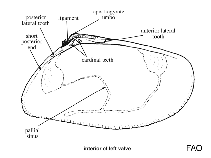Donax variabilis Say, 1822
Variable coquina| Native range | All suitable habitat | Point map | Year 2050 |

|
| This map was computer-generated and has not yet been reviewed. |
| Donax variabilis AquaMaps Data sources: GBIF OBIS |
Google image | No image available for this species;
drawing shows typical species in Donacidae.
Classification / Names आम नाम | उपशब्द | CoL | ITIS | WoRMS
Bivalvia | Cardiida | Donacidae
Environment: milieu / climate zone / गहराई सीमा / distribution range पारिस्थितिकी
; खारा; गहराई सीमा 0 - 11 m (संदर्भ 83435). Subtropical; 42°N - 10°N, 98°W - 63°W
Distribution देश | ऐफ ऐ ओ क्षेत्र | Ecosystems | संयोग | भूमिका
Western Atlantic: North America, from New York to Texas and Mexico, throughout the Gulf of Mexico. The Sea of Marmara and the Mediterranean: Introduced in Egypt and Turkey. Tropical to subtropical.
Length at first maturity / आकार / Weight / Age
परिपक्व अवधि: Lm ? range ? - ? cm Max length : 1.9 cm DL पुल्लिंग / अलिंग; (संदर्भ 83435); अधिकतम सूचित उम्र: 1.00 वर्षो (संदर्भ 8702)
Life cycle and mating behavior परिपक्व अवधि | पुनरुत्पत्ति | मछलीऔ का अंडे देना | Eggs | Fecundity | Larvae
Main reference
संदर्भ | संयोजक | सहयोगीयो
Bisby, F.A., M.A. Ruggiero, K.L. Wilson, M. Cachuela-Palacio, S.W. Kimani, Y.R. Roskov, A. Soulier-Perkins and J. van Hertum 2005 Species 2000 & ITIS Catalogue of Life: 2005 Annual Checklist. CD-ROM; Species 2000: Reading, U.K. (संदर्भ 19)
IUCN Red List Status
(संदर्भ 130435: Version 2025-1)
CITES status (संदर्भ 108899)
CMS (संदर्भ 116361)
Threat to humans
Human uses
मात्स्यिकी: निर्वाह मात्स्यिकी
| FishSource |
साधन
अधिक जानकारी
इंटरनेट स्रोत
BHL | BOLD Systems | CISTI | DiscoverLife | FAO(Publication : search) | Fishipedia | GenBank (genome, nucleotide) | GloBI | Gomexsi | Google Books | Google Scholar | Google | PubMed | Tree of Life | Wikipedia (Go, खोज) | Zoological Record



